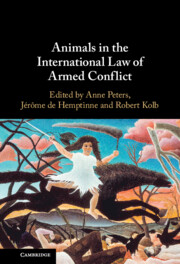Book contents
- Animals in the International Law of Armed Conflict
- Animals in the International Law of Armed Conflict
- Copyright page
- Contents
- Contributors
- Forewords
- Acknowledgements
- Abbreviations
- Part I The Need for Protecting Animals in Wartime
- 1 Animals in Wartime
- 2 Historical Perspectives on Animal Involvement in Wartime
- 3 Ecological Effects of Warfare on Wildlife
- 4 The Protection of Animals in Wartime
- Part II The Protection of Animals in International and Non-international Armed Conflicts
- Part III The Protection of Animals in Specific Situations
- Part IV Enforcement Regimes for the Protection of Animals in Wartime
- Part V Towards Better Protection of Animals in Wartime
- Index
- References
4 - The Protection of Animals in Wartime
Rationale and Challenges
from Part I - The Need for Protecting Animals in Wartime
Published online by Cambridge University Press: 06 October 2022
- Animals in the International Law of Armed Conflict
- Animals in the International Law of Armed Conflict
- Copyright page
- Contents
- Contributors
- Forewords
- Acknowledgements
- Abbreviations
- Part I The Need for Protecting Animals in Wartime
- 1 Animals in Wartime
- 2 Historical Perspectives on Animal Involvement in Wartime
- 3 Ecological Effects of Warfare on Wildlife
- 4 The Protection of Animals in Wartime
- Part II The Protection of Animals in International and Non-international Armed Conflicts
- Part III The Protection of Animals in Specific Situations
- Part IV Enforcement Regimes for the Protection of Animals in Wartime
- Part V Towards Better Protection of Animals in Wartime
- Index
- References
Summary
An inquiry into the rationale for the protection of animals in wartime confronts a key challenge: tThe progressive philosophical reflection on the improvement of the position of animals in (human) societies is at odds with the human-centred nature of international humanitarian law. Against this background, the chapter critically engages with possible reasons for animal protection in wartime: anthropocentric approaches, speciesism, anthropomorphism and a rights-based approach. It analyses to what extent these paradigms are reflected both in lex lata and in claims de lege ferenda. The chapter also examines to what extent these approaches can be brought in line with the overall objectives of international humanitarian law and reflects upon the challenges that arise from such an alignment. It favours a straightforward reform approach which aims at a specific convention for the protection of animal rights in wartimes.
Keywords
- Type
- Chapter
- Information
- Animals in the International Law of Armed Conflict , pp. 54 - 70Publisher: Cambridge University PressPrint publication year: 2022

